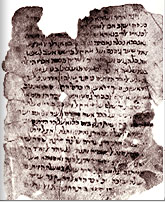|
courtesy of Yad Ben Zvi
|
|

The Cairo Geniza
|
This is a collection of documents, discovered at the end of the nineteenth century in the Ibn Ezra synagogue in ancient Cairo (Fustat). These documents were written in the Hebrew script, on parchment or on paper, in Hebrew, Jewish Arabic or Aramaic. The geniza - a repository initially intended for the burial of in-validated copies of the Holy Scriptures - included secular texts, which shed light on Jewish life in the Mediterranean basin during the tenth-thirteenth centuries CE. |
|
The Cairo Geniza was discovered by chance, when two Scottish women purchased scraps of texts and showed them to Dr. Zalman Shechter, a Talmudic scholar then at Cambridge University. Dr. Shechter, convinced of the authenticity of the texts, traveled to Cairo, where he retrieved more than 140,000 fragmentary texts, eventually presented to him by the Jewish community of Cairo. |
|
The Geniza has contributed greatly to our understanding of the translation of the bible and its exegesis preceding the days of Rashi, and the development of the Jewish Halakha during the Ge'onic period (7th-11th centuries CE). The Geniza also exposed us to original texts of important Jewish scholars, such as Se'adiya Ga'on (882-942), the Rambam (1135-1204) and Yehuda Ha-Levi (1075-1141). It taught us the rituals of prayer practiced in synagogues in Eretz-Israel and in Babylon at the time. Moreover, the study of the texts from the geniza exposed the rich cultural life of the Jews under Islamic rule, in fields such as art, music, philosophy and science, and the relationship between Jews, Christians and Muslims in daily life, as well as in religious controversies. |

|


